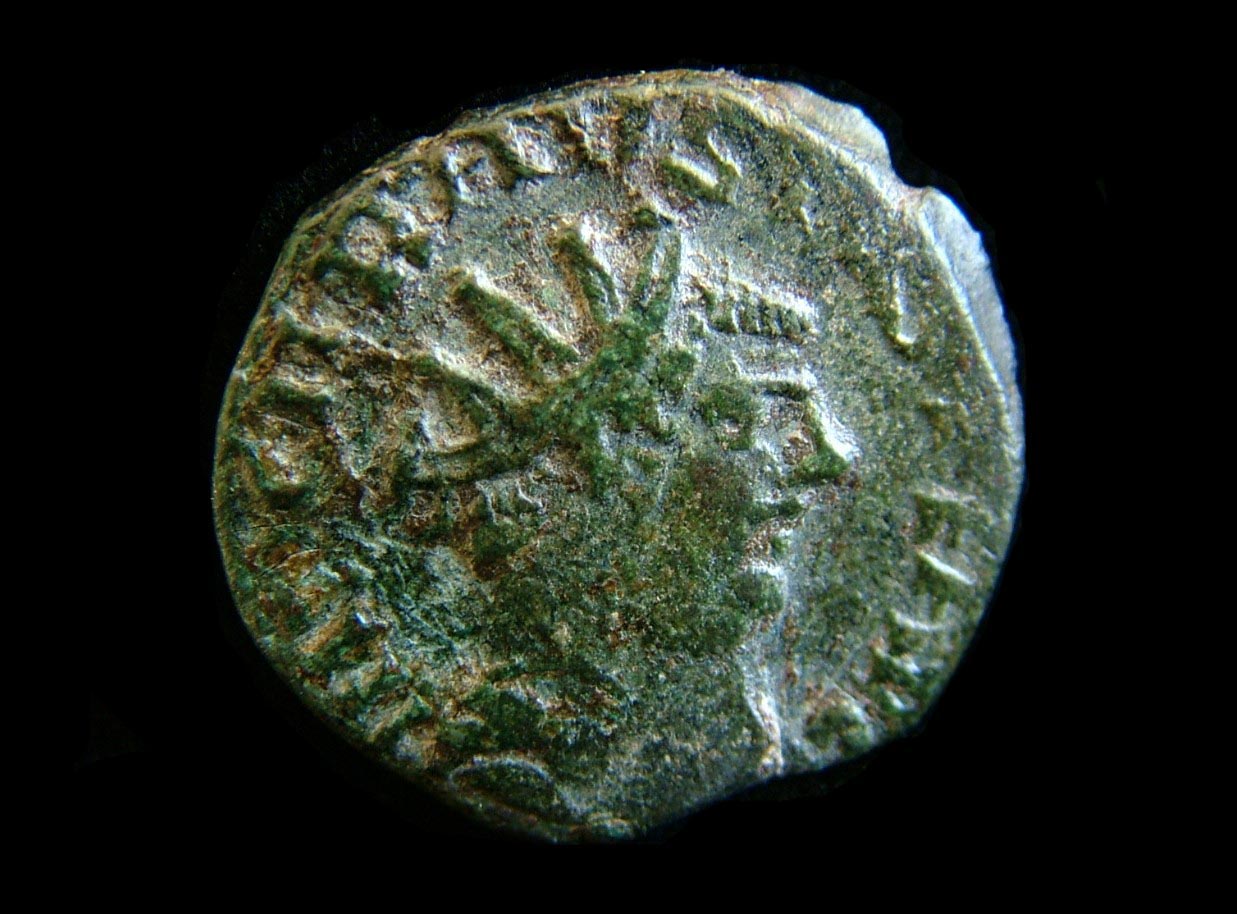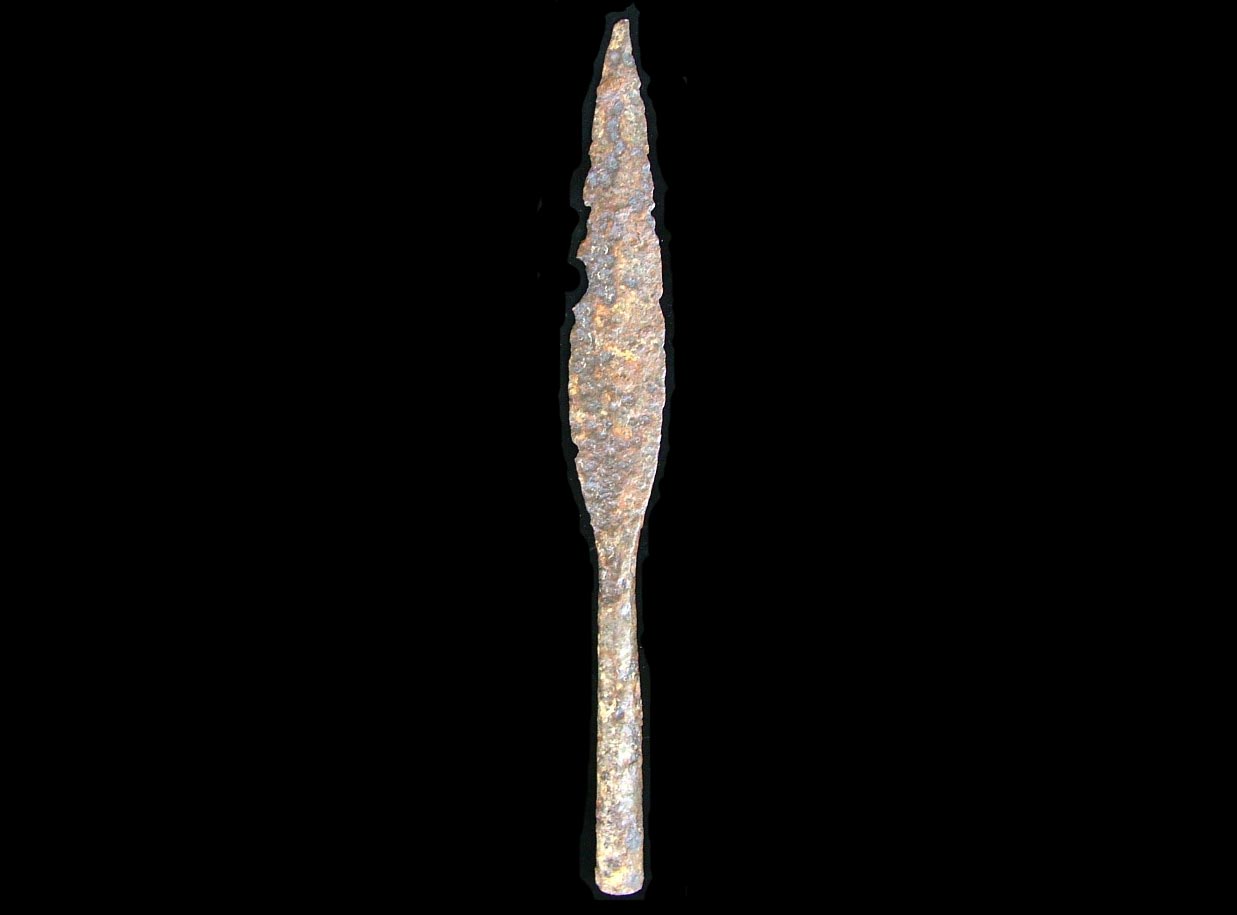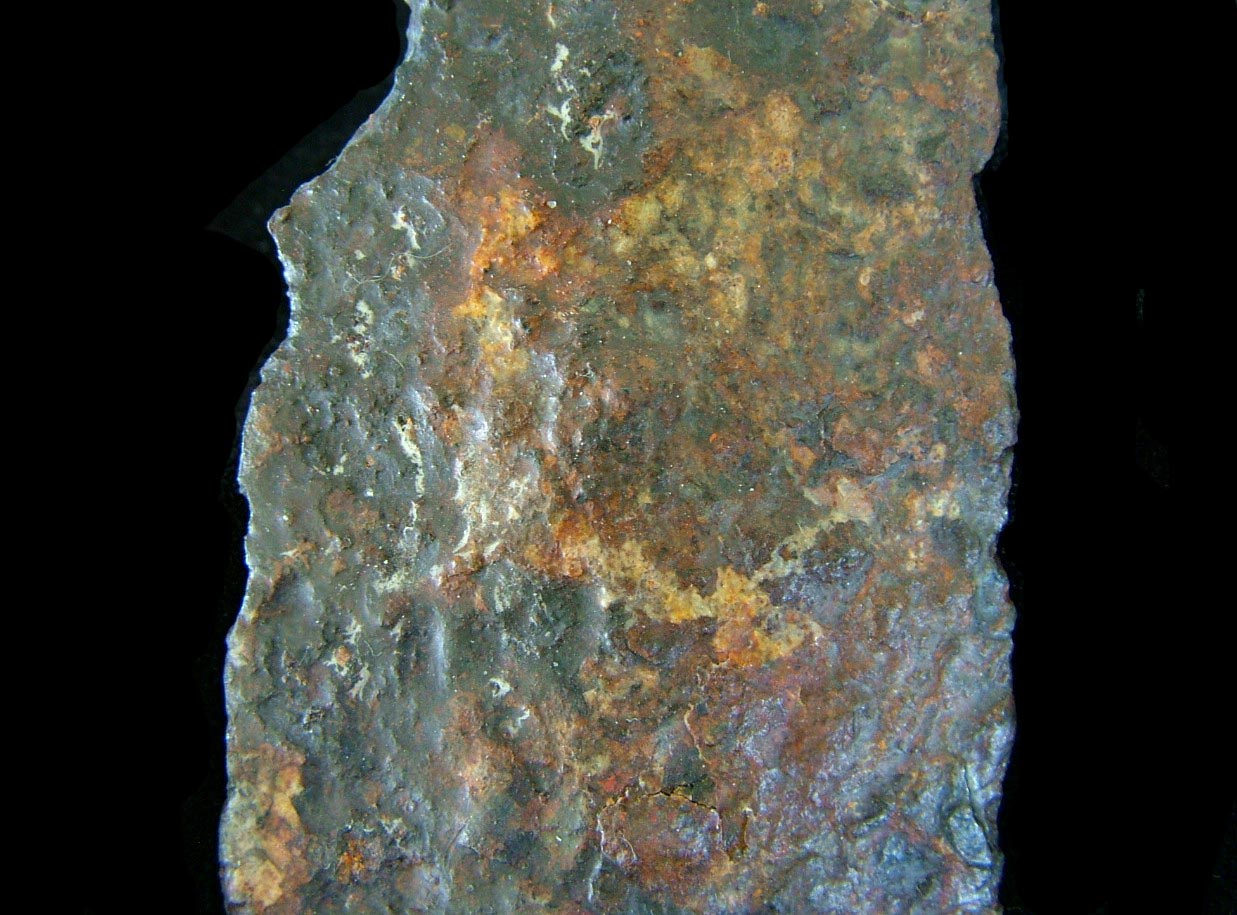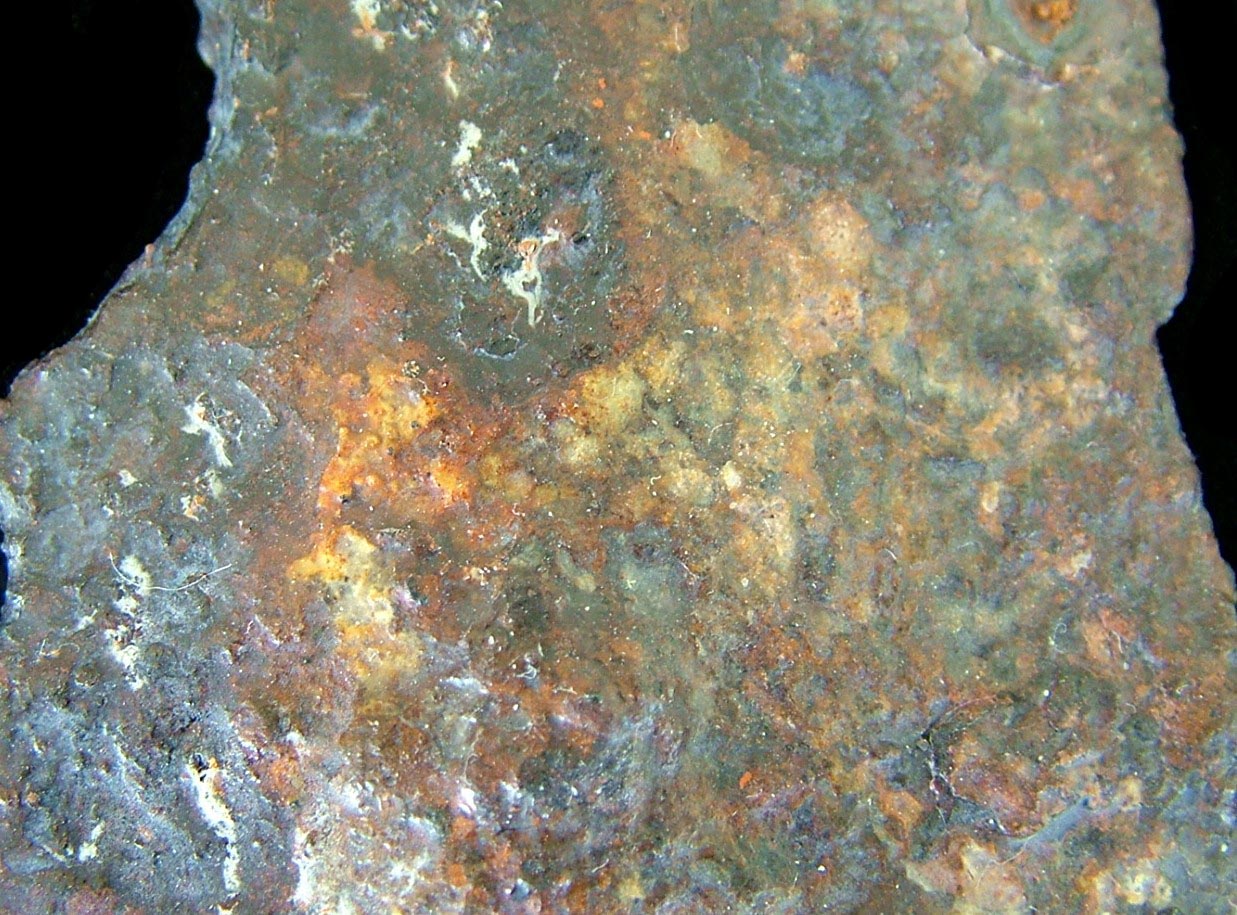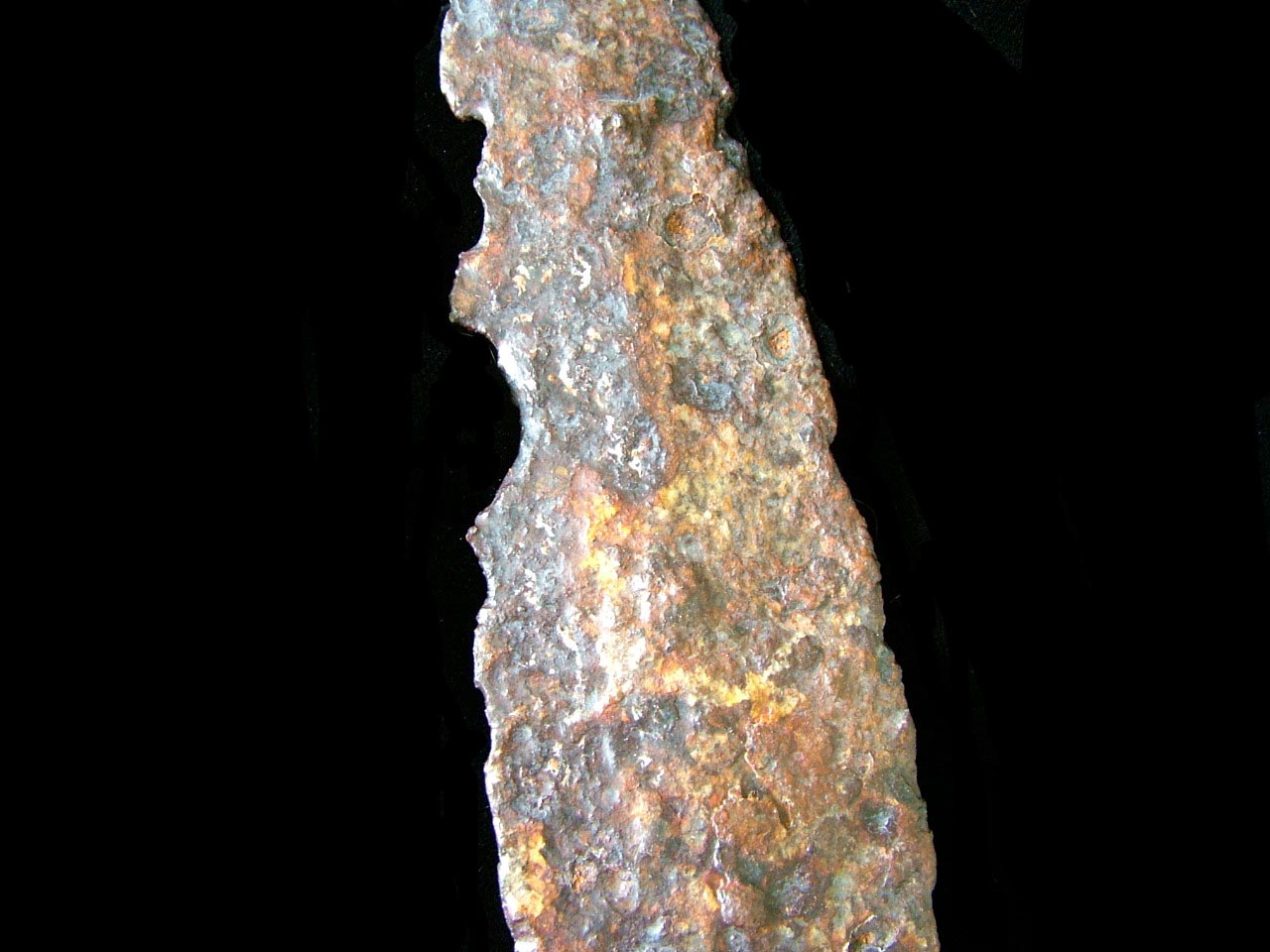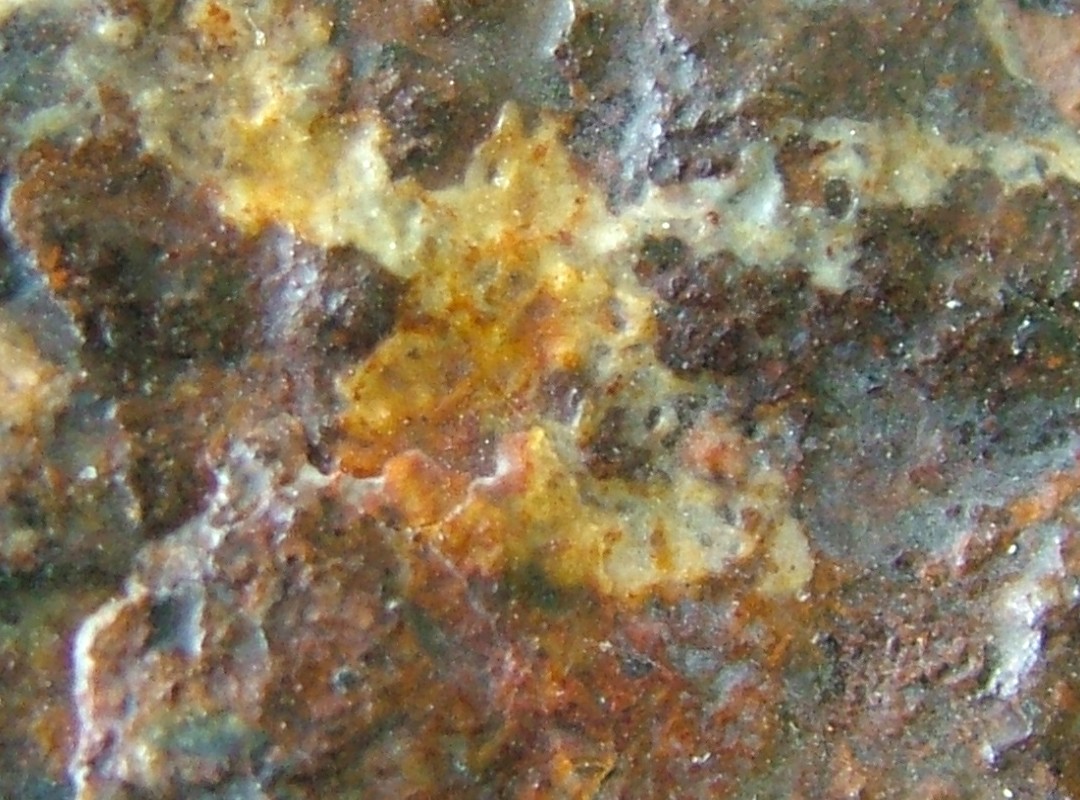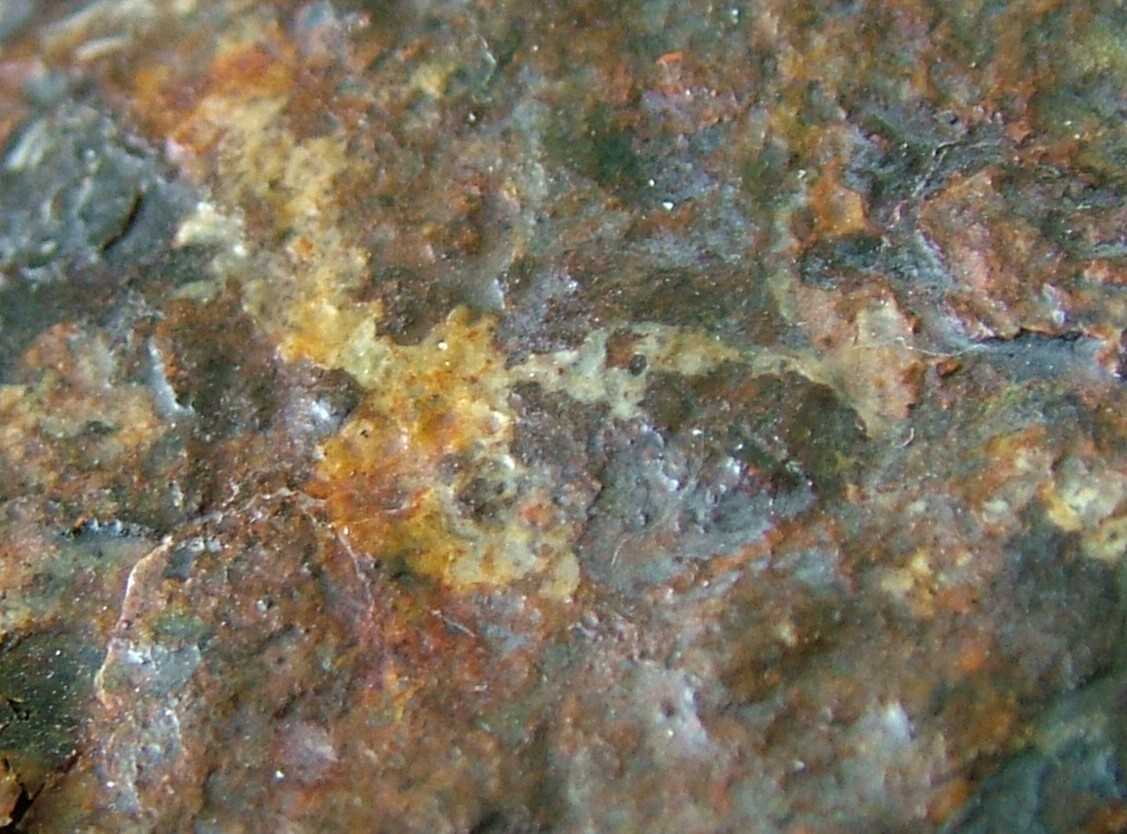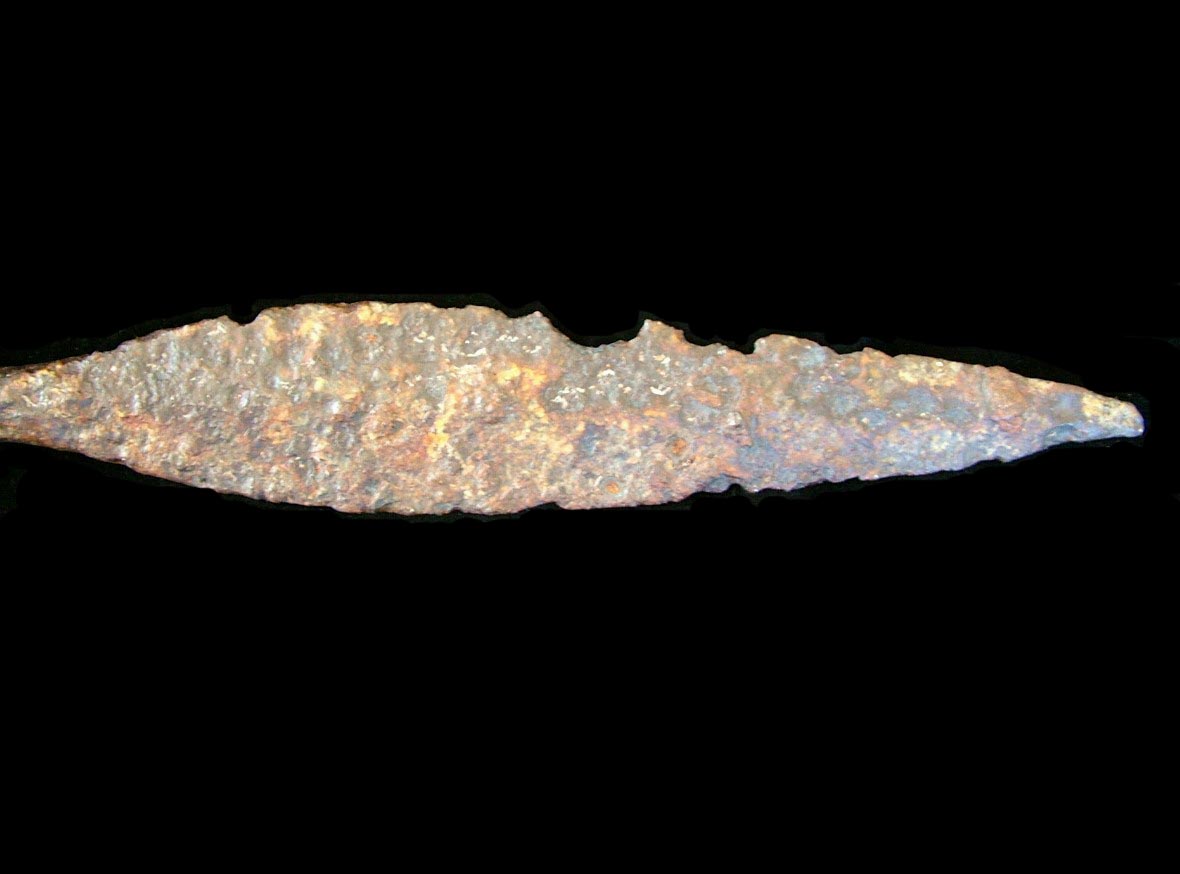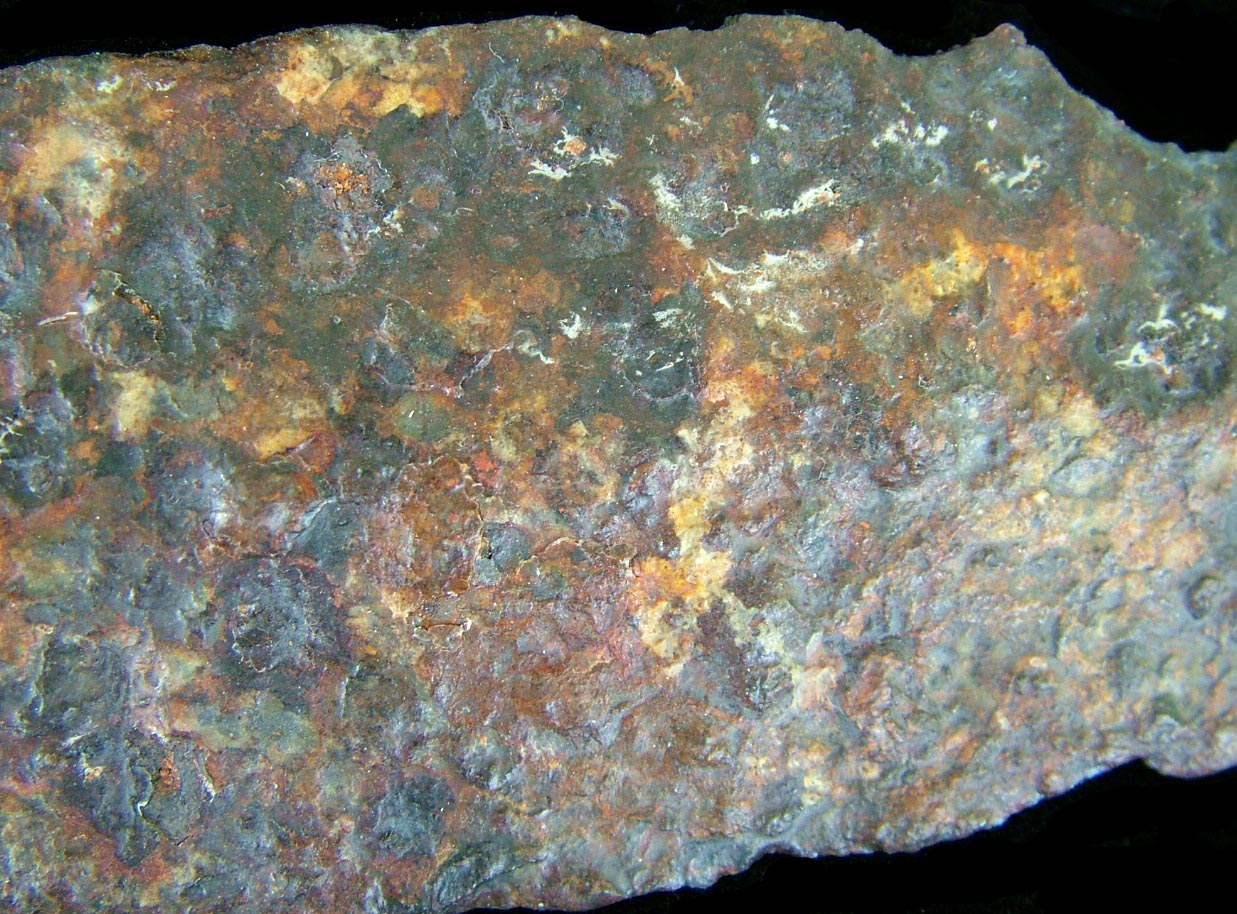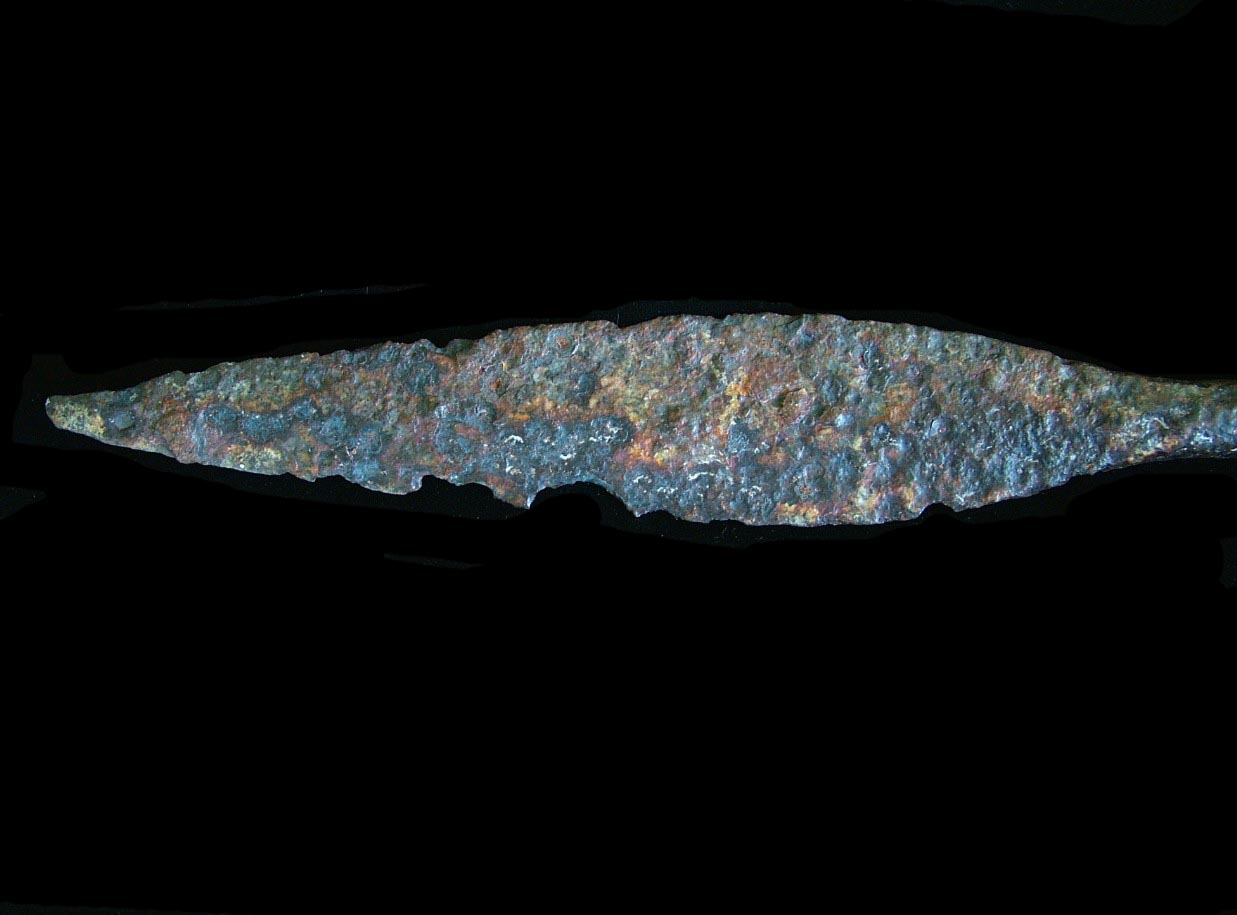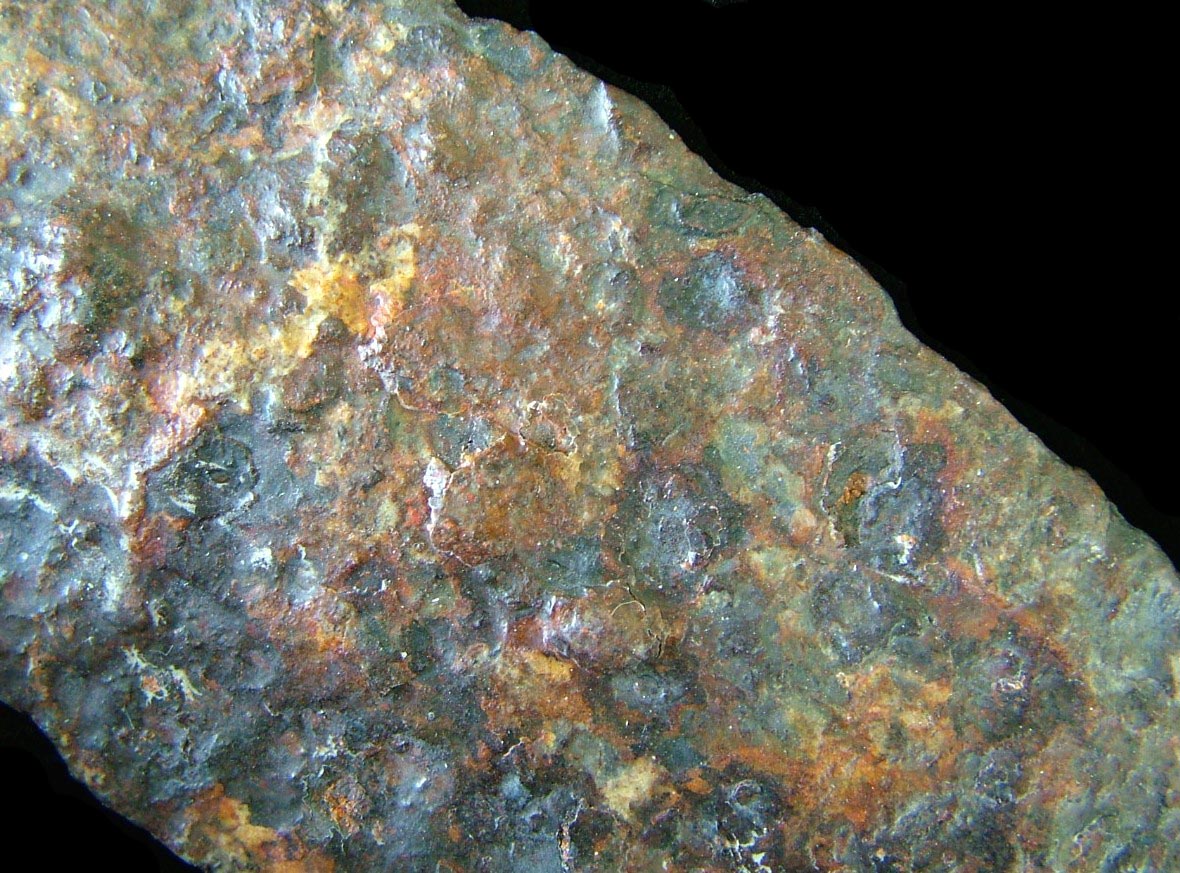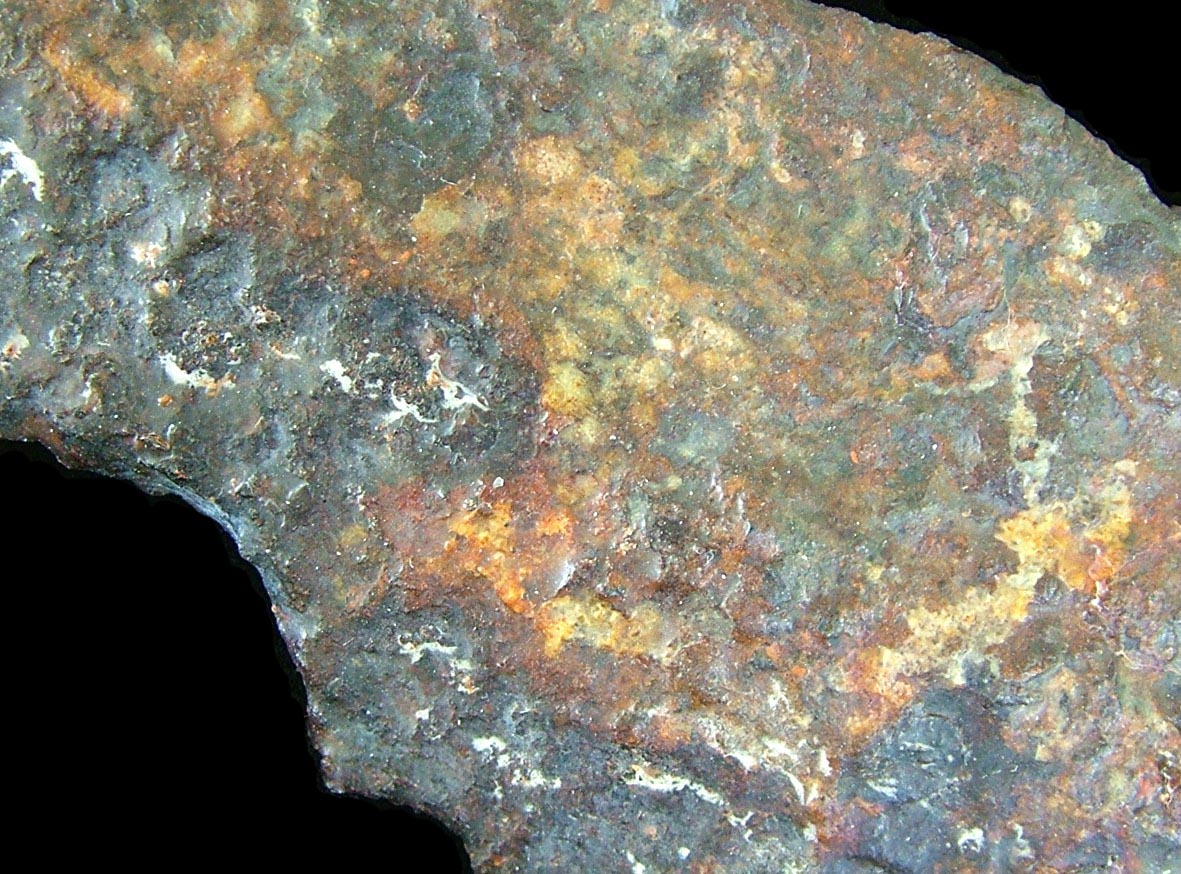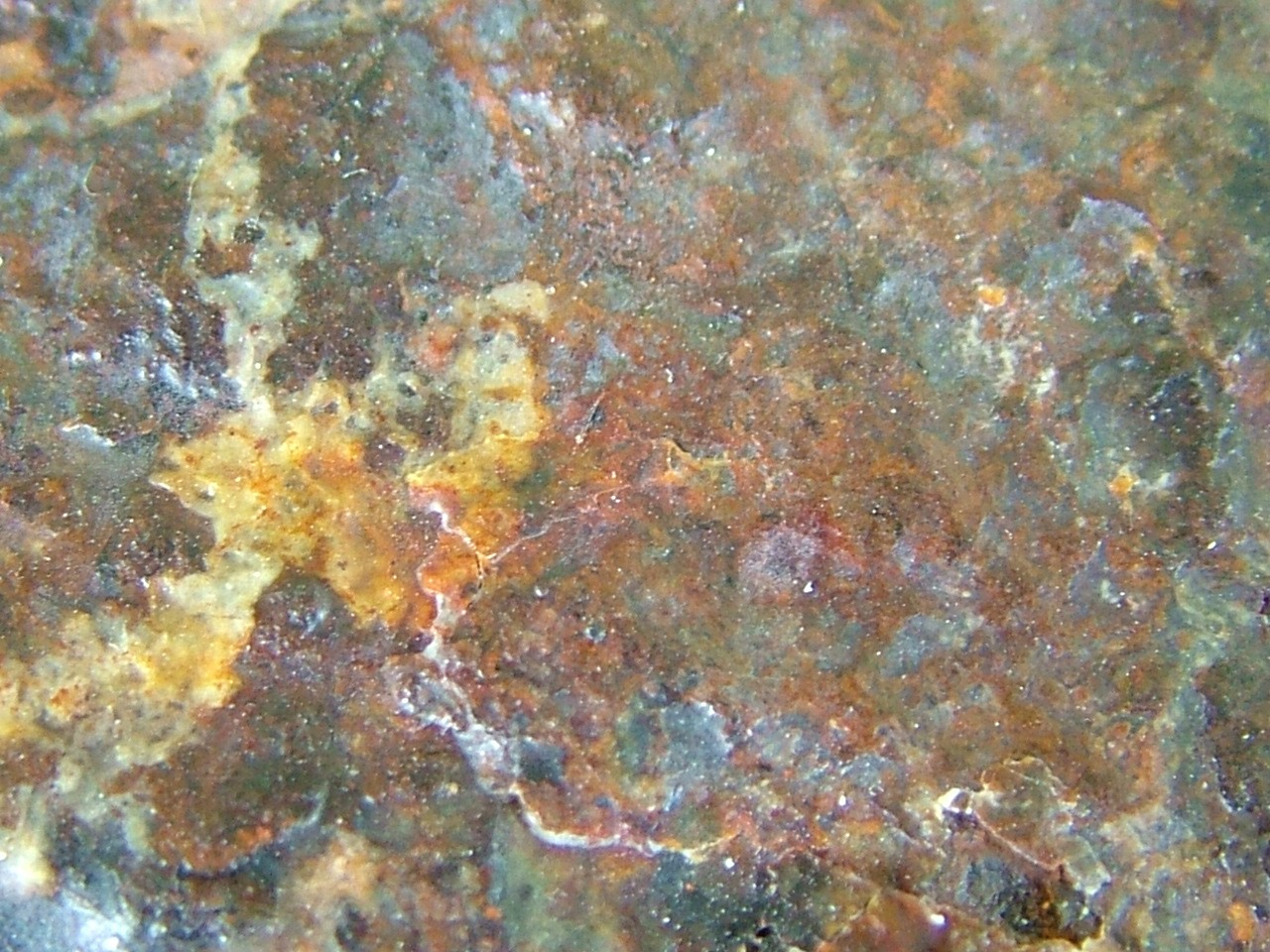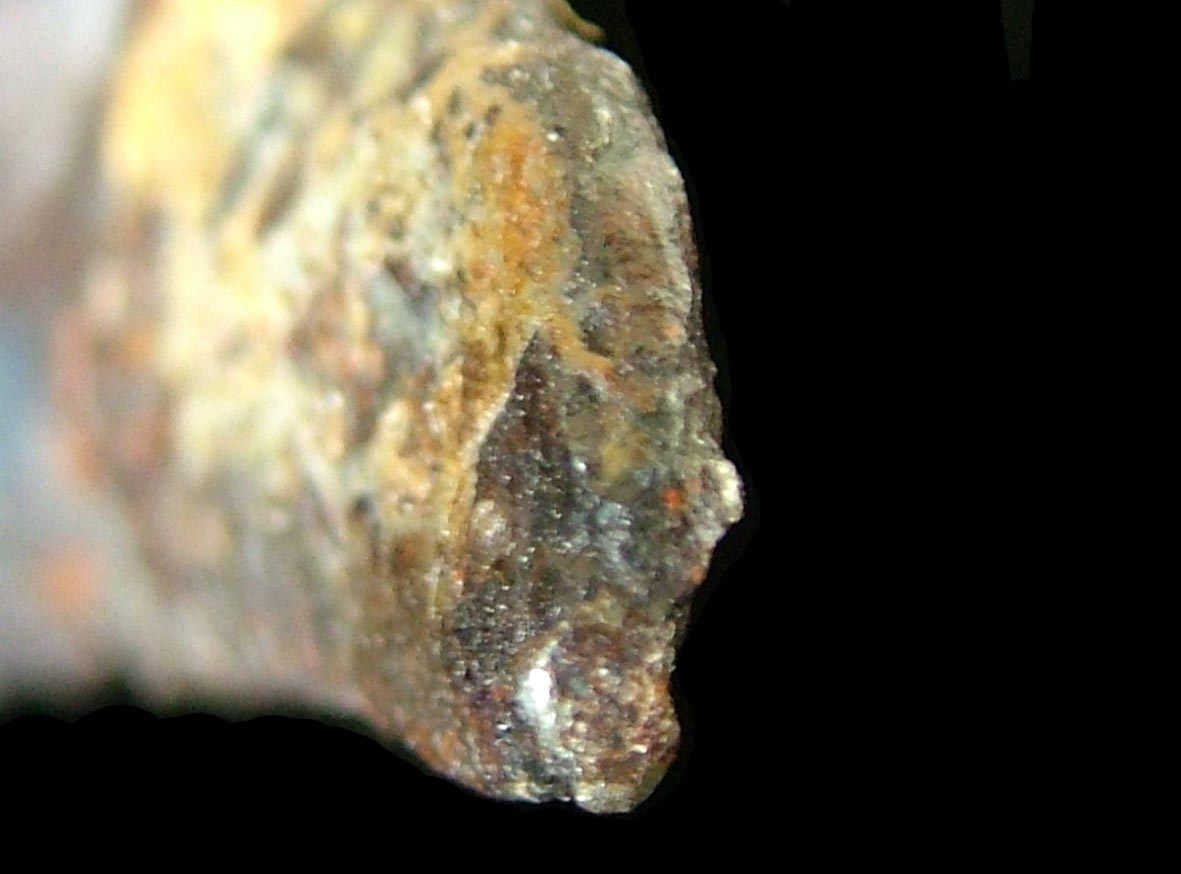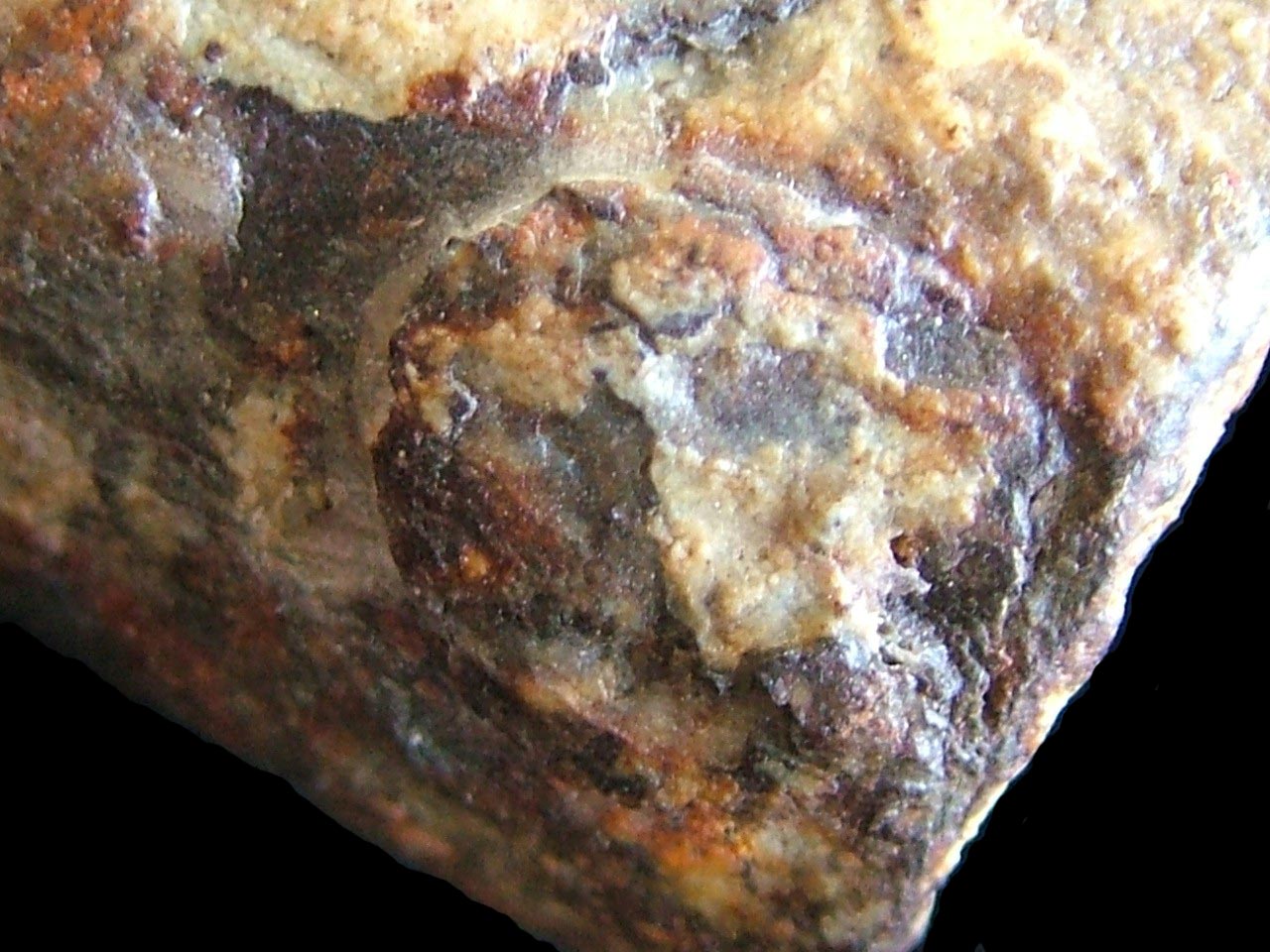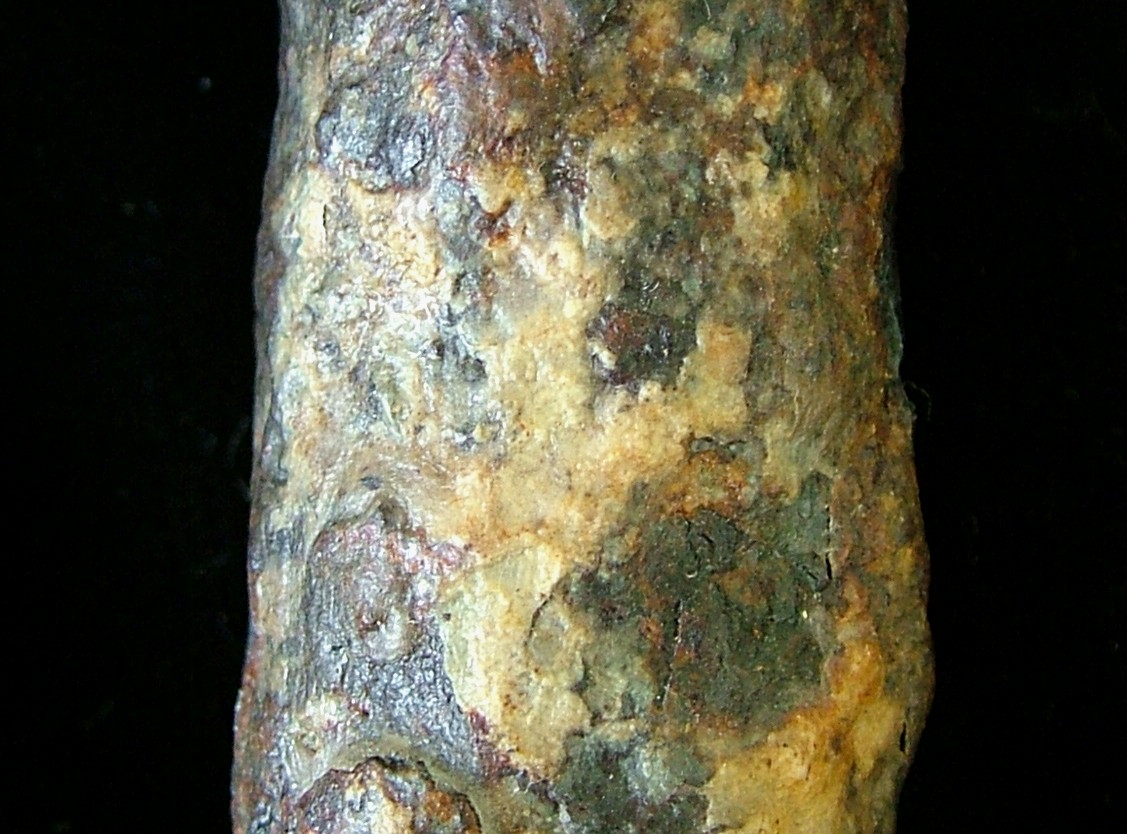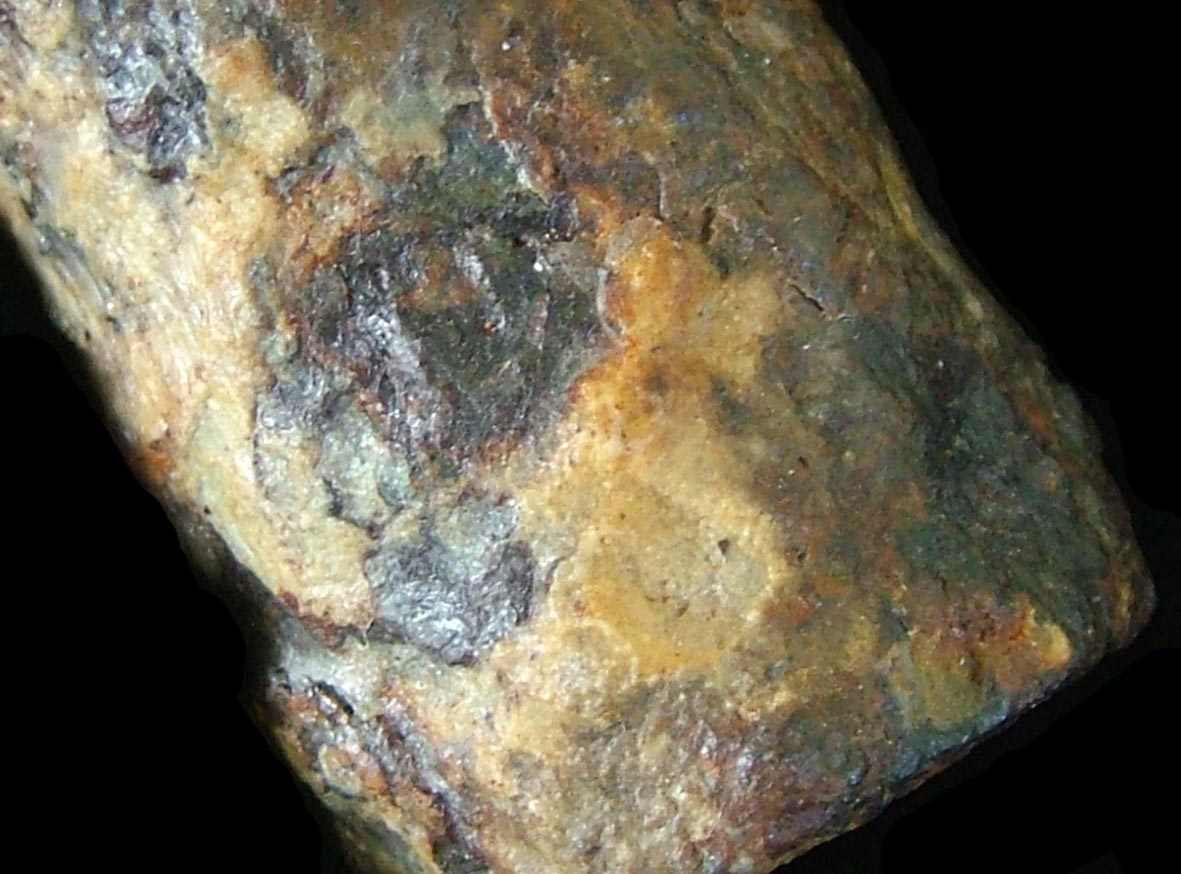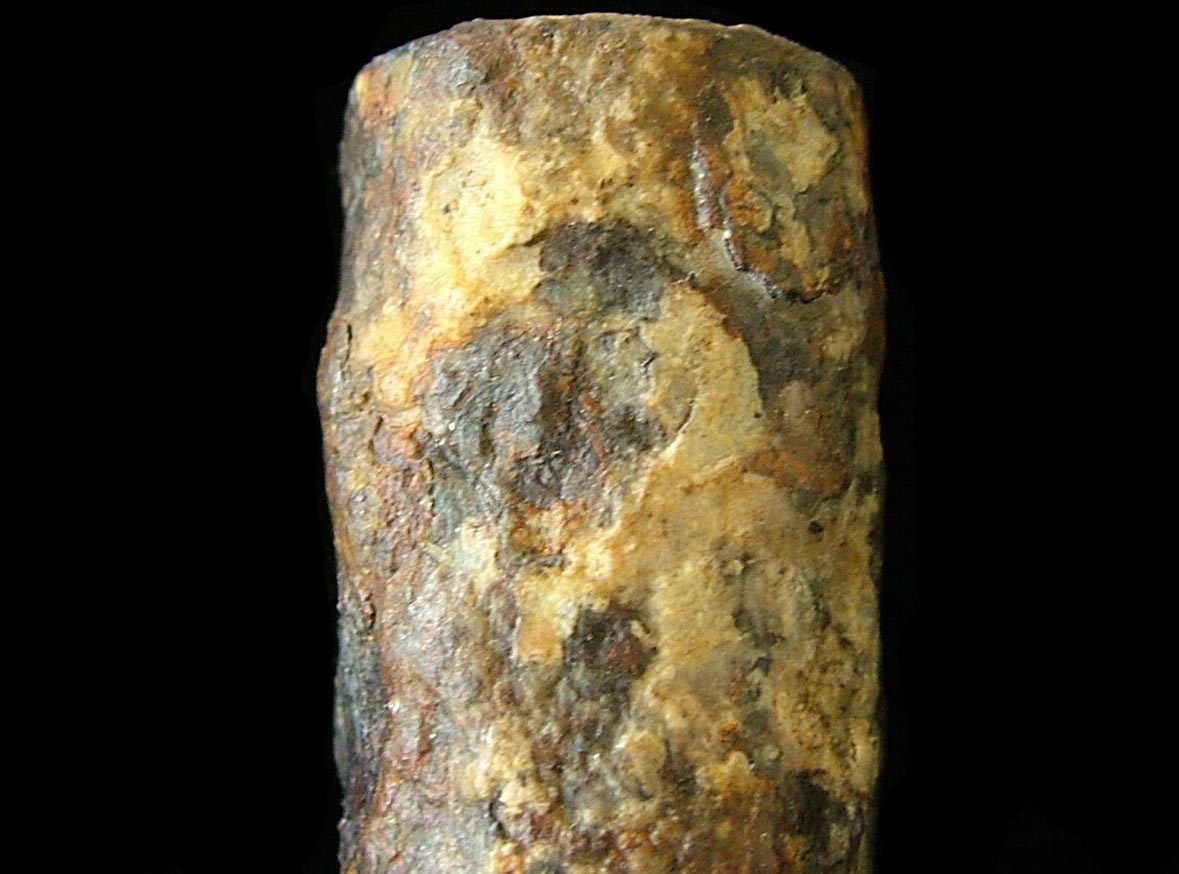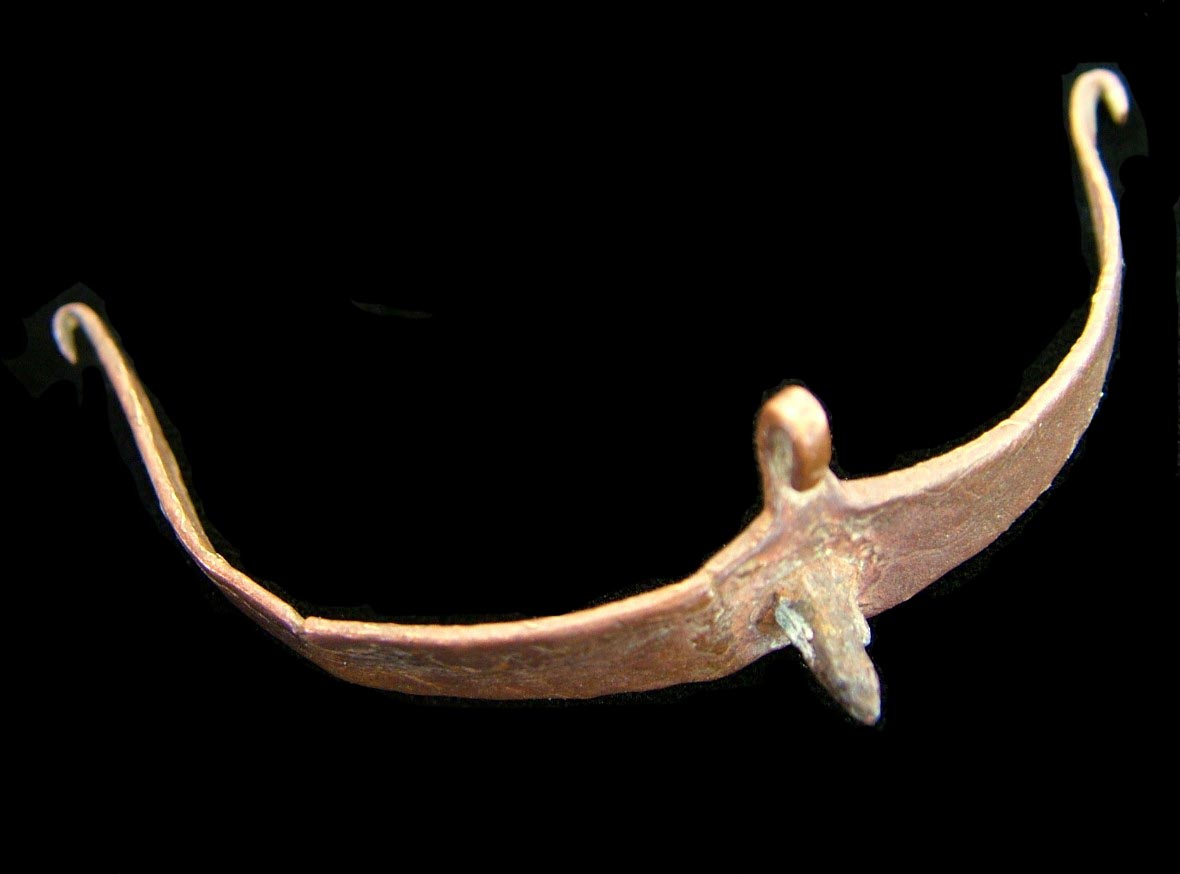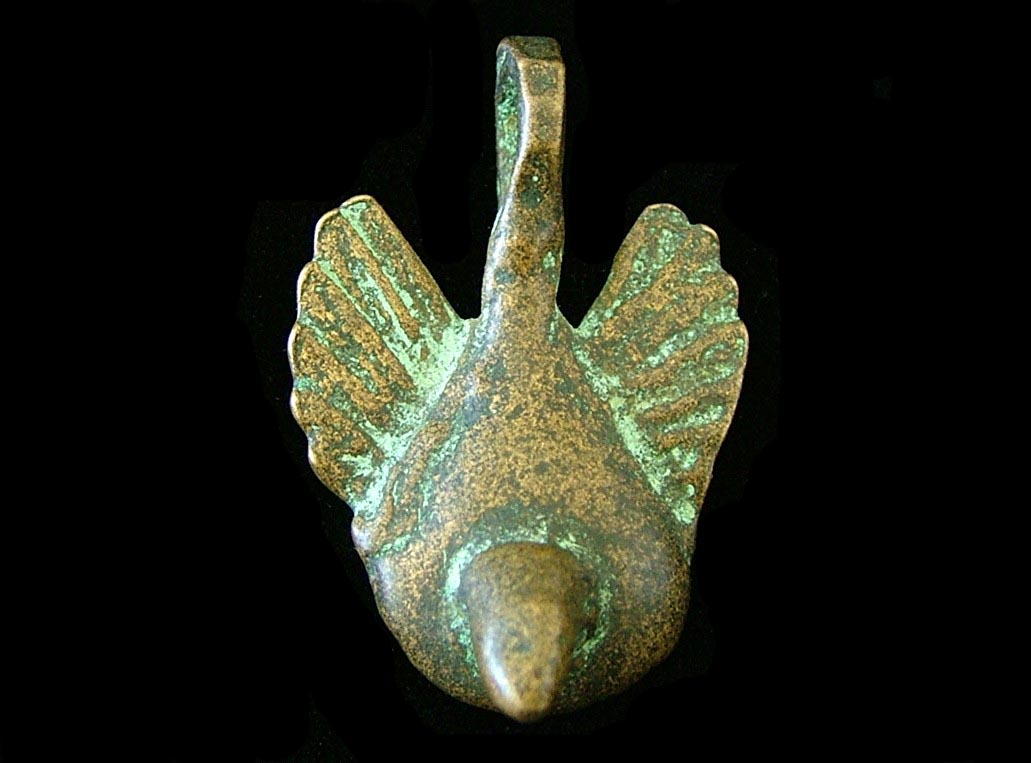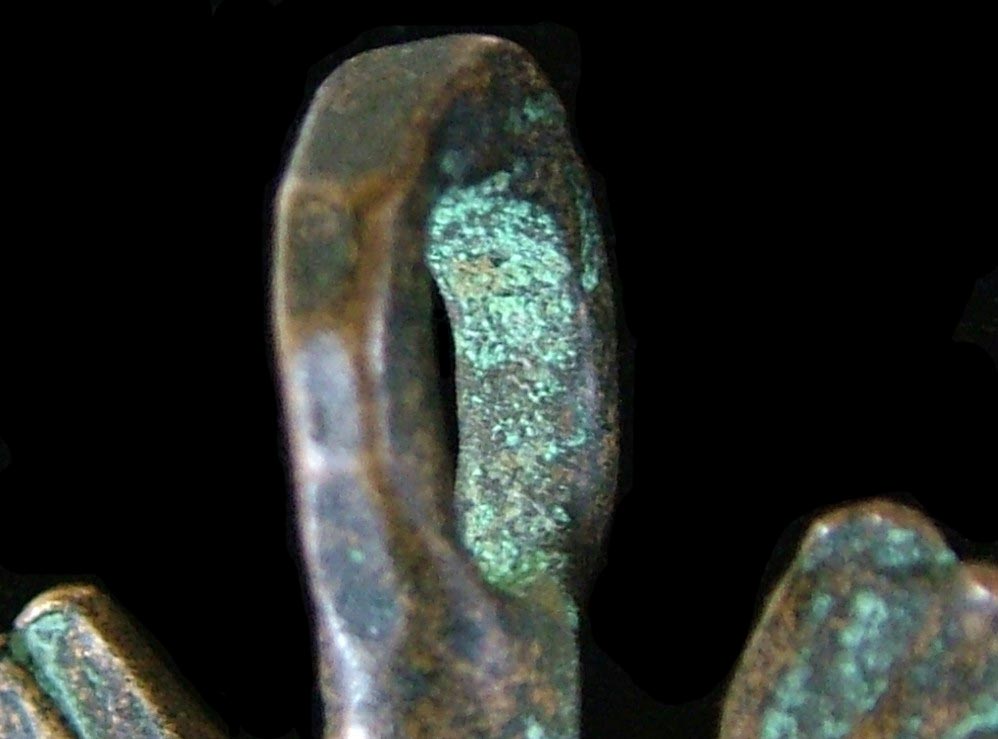 |
|---|
Roman Contos "Arthur Lance" |
|
| Title |
|
For Reference: Antoninianus Coin of Carausius and Mars Camulos Victor. Information. |
|
| Contos |
|
There is some adult content on this ancient artifact. This is a Roman Iron Contos Head of the 2nd C. to 3rd C. AD, it is pattern welded, for the period this is a rareity in itself. As a votive the contos head is complete. In my opinion the miniature art on this shows that the self proclaimed Roman co-Emperor Marcus Aurelius Mausaeus Carausius was the historical King Arthur. This contos was reworked or made as a victory or other votive to the Romano Celtic war/sword god Mars Camulos, a previously unknown Belgic bear god named Artor, and Carausius, Carausius's identification with the god Mars Camulos can be seen on some barbaric coins minted with his name. The Roman settlement of Camulodunum (modern Colchester) is named after Camulos, widely thought to be the origin of Medieval writers Camelot. It appears to be a votive from a Cavalry unit that was titled Ala Herculia Classis (Hercules Naval Wing), there have been no records of such a unit, but there is one record of a unit known as Ala Herculia Prima (the First Hercules Wing). The contos head was found on a hilltop in Norfolk County, England. It is sealed in wax and it appears that the wax is between 20 to 30 years old, so this gives some idea as to when it had been excavated. The pictures with this artifact are currently being edited, but once completed the miniature art and Roman inscriptions will show that among other things there was as a belief in a Belgic bear god named Artor (Arthur) in Britain during the Late Roman era, a sacred pagan cup, and the magical sword of Mars Camulos. The contos head has engravings on the iron, but it also has applied and engraved tree resin and bark on it. There is milled bone paste, ivory paste, shell paste, and paint. The tip has a small amount of a silver metal, unusually there does not appear to be any lead overlay present on the piece. The blade had been cut aa to appear as a flame, but also possibly as a plant or grain shoot. This group of pictures shows the contos. The art from top to bottom shows the following: The tip shows in profile a stout bearded figure in a cap. I have seen this type of figure with art on Nordic Neolithic artifacts, the figure may represent the north and, or winter. Pictures 15 thru 30 show a circle that is also hectagon, it also a large letter "C" and an "S", but then there is also another smaller "S", so for this type of art it reads "CS" and "CSS". In other picture groups an "AL" and an "H" are also seen to the left. What is not seen in any of the pictures posted is that to the left in raised letters that are not painted are the letters "ES", this should be the abbreviation for Equites as in Roman Knights. With this type of Roman legionary inscriptions letters and figures they almost always overlap and have several meanings. So the "CS" likely also stands for Camulos, but also Carausius. So if it is all put togather then it may read something like Carausius's Knights of Hercules Naval Wing dedicated this to Camulos. With the circle there is a capped figure's head on the top, he is not identified, but he could again represent a winter figure, what is worth noting is that he appears to have tattoos, there is another head over this. To the right there is a dark yellow or figure that is also in a cap, he appears to be moving the circle, it may be the demi-god Hercules. In Picture 24 the circle also hints of having an anchor. Pictures 34 thru 38 show the pattern welding. Copyright 2009 David Xavier Kenney |
|
| Circle Detail |
|
This group of pictures shows the raised work of the circle. A distinct "X" can be seen in the circle, in ancient art this usually represents a mystery god. Other pictures show that to the left there is a white serpents, a close shows that there is a long haired blonde figure and a black figure in the serpent's mouth. Further to the left there is a dark figure with long hair, it appears to be a woman, she may have cat like features. |
|
| Detail of the Circle, Torc, and Mushroom |
|
| This group of pictures shows more detail of the area of the circle. On the bottom there is a yellow figure that is as sitting in a torc. It is thought that to the Celts the torc was usually a form of identity as to the gods and goddesses of a particular tribe. Pictures 11 thru 15 show the area of the torc figure in a different position. It is now transformed into a mushroom with a capped figure on top. |
|
| Torc, Ram God, and Sword |
|
| The first couple of pictures show what may be a raised sword with a cruciform hilt. Pictures 3 thru 5 show the torc has a head with ram's horns (the ram is an animal associated with Camulos). With this it shows that the head is also an enclosure, there is a small standing bear that is facing what looks like a grain seed that has an opening. To the right of this and connected to the seed's opening is a ball, this is the pommel of a sword that only has part of the blade showing. If you focus on that ball pommel with the rest of the pictures in this group you will see the sword in various positions. Along with this the torc area will transform into various forms, but it is always connected to the sword. |
|
| Ram God, Sacred Cup, and the Making of a Roman Parazonium |
|
Pictures 1 thru 6 show the ram god, the standing bear could now be seen as a totem, it suggests that this was the first totem or the primary totem of a tribe. This appears to be associated with the grain seed that now looks like a barley seed, this all may represent the planting of barely. Behind the bear is a figure holding a ring, another figure with a red ball face is taking the ring. The figure with the red ball face is The torc now hints that it may also be a hide boat that has foam in it, there is also a hint of a cross. Pictures 9 thru 12 show this area at an angle. Overall it shows a face in a hood, a boar with a shield, and a knife that is also a fish with it's mouth open. Pictures 13 thru 18 shows a cross in what was the torc, with this Pictures 14 and 15 show that the cross is connected to an evergreen tree that has a red dot in the middle. This should represent a holly tree. When the knife is put together with the smaller figure, the figure with the red ball face, the position of the fish knife, and the holly tree; then it appears that this is an Attis type legend. There is a suggestion that the barley and holly berries were used in the making of a drink, if so then there must be a lot more to this (with ingredients and, or processing) is as holly berries are poisonous. Pictures 21 thru 23 show the sword with a mountain type figure, it as if the sword is in or connected to an eye of this figure. Pictures 24 thru 27 shows this area has now transformed into a triangular face. It is also a cup with a cruciform hilted knife in it, it's tip can be seen as a yellow fang. The cruciform hilt is also a bar hilt. To the right of this is a face in a helmet that is also a face with a cup with a ring handle. There is an object that is as if descending on a horizontal "Y" over the cup with a ring handle. My research shows that the "Y" symbol in antiquity is usually associated with the magnetic. All this should be of a sacred cup or cups. Pictures 27 thru 30 shows the figure with the triangular face pulling or holding an eagle headed Roman Parazonium (an elite Roman ceremonial short sword or long dagger), there are two small balls in front of the eagle's beak, my research shows that when seen with a blade weapon that it is a symbol of iron associated with meteors/meteorites. Pictures 33 thru 38 show the making of a Parazonium, but more importantly it also shows the making of it's sword chape, it is thought that the chape was either just important or more important then the sword itself. |
|
| Sword Puller |
|
This group of pictures shows the sword being pulled, on the blade there is a figure holding a cube over this, there is also a mustached figure as if holding the blade. |
|
| Mars Camulos |
|
The main theme with this group of pictures is the Romano Celtic war god Mars Camulos, he is shown on a wolf or a type of sled dog reaching for a sword in the ground (or stone, ect), there are many animals with this, as well as what appears to be other gods. There is a great deal of thrust and abstraction in this scene, it shows the Camulos is a northern sea storm god (or a god that pushes through those sea storms), both also that both he and his animals are forces of nature. Although this god appears fiercer and more like the Greek Aries, he is more or less the same as the Roman god Mars, that is he is an agricultural god that becomes a war god. With that said it appears that Camulos was also more associated with the the seasons, the weather, the sea, and also with wild animals. The god Mars Camulos appears with a goat or ram's head. on top of this is a white fox (perhaps representing stories heard of the Arctic fox). Over this is what appears as two antennae that is also a white serpent type banner that is flying forward.. His left hand is also the crest, it is also a Roman curled phallus symbol, and also a claw. Picture 2 shows the letters "M" and "A" and "C", the letter "A" is also a diamond with a small circle in the middle. THis should represent the letters for Mars Comulos, but it could also stand for Marcus Aurelius Mausaeus Carausius. To the ancients the diamond was a symbol of birth, this symbol is significantly more often seen in; Northern to Central Europe, the Balkans (it was a national symbol of the Thracians and the later Dacians), and Northern to Central Asia. With picture 7 there can be seen a raised figure that is a horse but it is also a bear. Inside this bear horse combination creature there is also a primitive looking long haired man with a mustache. He is connected to the sword in the ground (or stone, ect) and is holding a chain over the forehead of the wolf or dog. This appears to be the god Artor. The wolf or dog is emitting a wavy stream from his eye, this may or may not represent something like the aura borealis. |
|
| Mars Camulos Breaking Through and North Sea Volcano God |
|
This group of pictures with different natural lighting, details and angles shows the even fiercer warrior aspects of Mars Camulos, they also show what appears to be a sea god of the North Atlantic, and that this god is connected to a volcano (most likely heard from sailor stories of Hekla, Iceland). The pictures show that if Mars Camulos's right hand is reaching for a sword, then his left claw hand is forward and already doing damage, there is a hint that the claw may also be some form of electrical charge (such as a specific type of lightning). There is also a suggestion that the claw is sweeping aside a torn phallus (note that with this the "C" claw is also a Roman curled phallus). Other views show that area as a shield wall and with another view, then just under this is an attacking human figure. Picture 11 shows what appears to be a fantastic combination sea creature. With some pictures the back of the wolf or dog's head is now a bovine or deer's head that has two round balls for horns, as this appears to be an opposing animal the two balls may have to do with the taking of it's horns. Pictures 18 and 19 show Camulos now with what may be a boar's head, there is a ropes over his snout with a line of smaller figures in front as if trying to capture or stop him, the rope appears as if it is giving way to the god. Pictures 20 and 21 show the detail of the white serpent streamer. Pictures 22 thru 31 show details of the battle scenes with the claw. Pictures 32 thru 37 show the sea god in a pointed hat, he is in white outline, the serpent is part of his hat. With this Picture 39 shows that the sea god is also part of volcano, this hints that the claw may be a volcanic electrical discharge. |
|
| Mars Camulos Victrix |
|
Pictures 1 thru 6 show many figures as if in a line, most noticeably there is a large red bearded figure and blonde bearded figure, both are wearing ancient Germanic type Cossack hats. Pictures 7 thru 13 show a large Roman styled eagle over a scene of conflict. There is a type of abstracted spear head under this, when put together with the previous pictures it shows that the figures in a line are on top or behind a very long spear. With the rest of the pictures, the scene in the spearhead shows a legionary eagle standard with the letters "VC" on it's chest, this should stand for "VIC" as in Victrix (Victorious). Under this there is a flattened "X", there is a head on it that faces the viewer. To the right there is a partially nude large breasted exotic woman that may be wearing a veil, she is holding a small creature in front of her face, the creature's tail end is over her nose. A first guess is that the animal is a skunk, but there were no skunks in Europe(the closest skunks that would have been in North America, unless some sea travelers had been there), anyhow an easier guess is that it is a water shrew. When the animal is seen the other way around it appears as a bird. |
|
| Sword and Trident |
|
This group of pictures shows a gladius with a large pommel that is also a one handed short spear, there is also a trident and a ship with figures in it. To the right of this and next to the pommel is a helmet, it may be an Attic helmet with no crest. Besides any other meaning these may have, they appear to be primary symbols of a Roman Naval Commander. |
|
| Eagle and Anchor |
|
This group of picture shows the hectagon and the anchor. There is a long haired man's head on top , then the eagle to the right, under this is in yellow is an abstracted figure that is prone, to the left the sword hilt appears to be holding flowers. The prone figure's extra long nose hint that it may be a bee goddess, there is a scene above this, there may be heads on the prone figure, there is a hint that there may be a sexual act. Pictures 9 thru 11 show another view of the woman holding the animal, among other things she may also be holding a head of a man with a mustache. |
|
| Pictures For Edit |
|
| Contos with Point Down |
|
This shows the contos with the point down. There are various figures, faces and scenes on it. |
|
| Contos Tip |
|
This group of pictures shows the contos tip in various positions. There is one bit of a circular piece of silver metal on the tip. Picture 2 shows a figure holding a ring, this should be a victory wreath. Pictures 3 thru 7 show a figure in a hood. Pictures 8 thru 13 show a figure that may be holding a mirror that it is upside down. Pictures 14 and 15 show what appears to be a bird dragon's head, it hints of a streamer. Picture 16 shows a figure in a helmet or hat as if pulling what could be a child in a basket. Pictures 17 thru 18 shows that the basket is now an egg or a bowl with figures in it, there may be a letter "M" on it. Pictures 20 thru 25 show a large face, in front of this there is a long fish that is also a boat, inside the boat there appears to be figures in the boat that are disembarking. With this in Pictures 24 and 25 shows that there is a boat and another face on the large face. It appears that this scene is of some type of assault from the sea. |
|
| Contos Socket Rivet |
|
My research with ancient miniature art shows that rivets and holes were areas that were focused on. Themes with rivets tend to have to do with victories or anything that penetrates such as pointed weapons, assaults, and meteorites. With holes, the themes tend to be of a mystery, the other world, or a defeated enemy (or enemies). In this instance this rivet has a primary theme of a meteor/meteorite. Picture 1 shows the rivet painted as a large face, there is a hint of a ship under this, with this there is a small white figure, to the left there is a figure on stairs. This pictures thru Picture 11. Of note is that in Picture 9 the small white figure in the boat is blowing on a ram's horn, but yet is seen in Picture 11 with a whip. The rest of the pictures show that the boat is actual some type of large smithery and that the meteorite head is inside of it. In some of the pictures to the left can seen a figure in a conical hat and a long staff with a quarter moon. There is also an interesting figure best seen in Picture 24, it is on top of the meteorite head, it is a prone figure with a beard, the face is actually two faces, there is another bearded head behind him. |
|
| Pictures For Edit |
|
|
|
| Contos Shaft Base |
|
The pictures with this group are of an area on the base of the contos. They are specific with the next picture group that is of this same area, but turned upside down. The pictures show a darker area that overall shows somewhat of a face with a beard. To the right of this is a letter "S. that is also a serpentine figure in a cap or helmet, there may be other letters or bind letters. Inside the face there is a scene, it may have something to do with a tree shoot and, or a pointed hat. |
|
| Contos Shaft and Artor |
|
This area of the contos shaft is of this same area as the previous picture group, but it is turned upside down. It also shows the face if a bearded figure. On top of this face is what appears to be a Roman 3rd C. AD sword sheath's box chape. On this there are letters,figures and a scene. The letters read "CUSAS", but also "CVSAC", the word cusac may be a combination of the Celtic word "cu" and the Roman word "sac"that means sacred hound. The face under this has a helmet. On the helmet there is a figure that is also a letter "R". The nose is as a "T", but it is also a long snouted dog or wolf's face. The face's mouth and chin have an engraved letter "R", but yet it may also be a letter "C". The "A", "R", "T", "OR" are vertically lined up as to read ARTOR, the if "OR" is also a "C" then this could be for either Carausius, or Camulos or both of these. To the right there is a bear with a turned up nose, this is a specific type of bear that may have been associated with bees, I have seen this type bear with other Roman artifacts including weapons that have some Germanic influences, next to and on the front of the bear is a rectangular horse's head, when seen from another angle these appear connected and on the back of a man's head. When the top of the helmet is seen in some pictures it shows the "R": as a face with a serpent and other figures under it. The name "Artor" in connection with Germanic and Germanic Celtic tribes (such as the Belgic tribes are), a bear, bee goddesses, sea goddesses, a sacred mountain, the sea, and weapons was found on the "Varus Avenger Statue" that is in the Roman Officer Permanent Collection in the military category. It is currently archived but is expected to posted again soon. The overall bind letters and figure letters inscription may read something like "the sacred hound of Artor". |
|
| ROMAN CAVALRY SPUR |
|
| This is a Late 2nd to Early 4th C. AD Roman Cavarly Copper and Iron Hoop Spur, the fact that the top loop-hook has paste that is engraved suggest that it was a grave find, it is very likely that it had once belonged to a Germanic tribesman in the service of Rome. There are figures and scenes on and around the iron prick, they may have something to do with an iron mountain in the north (perhaps symbolizing magnetic north). The reason that this spur is included with the Roman contos is do to the engraving of a dog or long snouted wolf's head on the head of a figure on the on outside of the copper spur (this can be seen in Pictures 22 thru 25). This is somewhat simular to what is seen with the wolf or sled dog in Pictures of the Mars Camulos Picture Group. Both these and images on other artifacts suggests that there was ancient belief that a dog or a wolf was associated with the aurora borealis. The origin of this may have been with the Sami (Laplanders) and, or Finnish legend of the fox's tail and the aurora borealis. |
|
| Roman Germano Celtic Cavalry Pendant 1/1 |
|
This is a Late 1st to Late 3rd C. AD Germano Celtic Cavalry Bronze Pendant, it also has other alloys that with movement cause it to vibrate (this is shown for effect with a slightly blurred image in Picture 6). The overall theme is of a dawn/dew goddess as a partridge (or a pheasant), a phallus, and a specific aspect of the god Mars, there are also nautical creatures. Symbolism with various ancient artifacts show that the ancients believed that the transitional periods of dawn and twilight have aspects of both sexes. This pendant came from an extensive Roman pendent collection of an American ex-sailor who had been stationed in Gaeta, Italy during the late 1960's and during the 1970's, he traveled throughout the Mediterranean. In my opinion it is likely that this particular pendent had originated from a coastal area in Campania, Italy. |
|
| Roman Germano Celtic Cavalry Pendant 1/2 |
|
This group of pictures shows the detail of the inside of the back of the pendant loop. Pictures 1 thru 4 show a figure in a beard and mustache holding what may be a torch with a flame. Pictures 5 and 6 show the bearded holding what may be a horn cup with a face on it, on the outside of the loop there is a figure in a long gown. Over the bearded figure is an elaborate helmeted figure with a rectangular shield (the bearded figure is on the shield), it is if he is looking up at the figure in the long gown, this may be the god Mars. The gown could also be seen as a shooting star that is perhaps the dawn's dew going into the horn cup. Pictures 7 thru 10 show a scene with figures on the inside of the band. Pictures 11 thru 14 show in the indentation a head of a Germanic tribesman, inside the head is a figure (that may be eating a leaf) and animals. Pictures 15 thru 19 show the pendant back upside down. It appears as a woman with long hair, on each side of her there is a grotesque head, the over all form slso suggests a mirror. The inside of her face once again has a scene with various figures. Copyright 2009 David Xavier Kenney |
|

